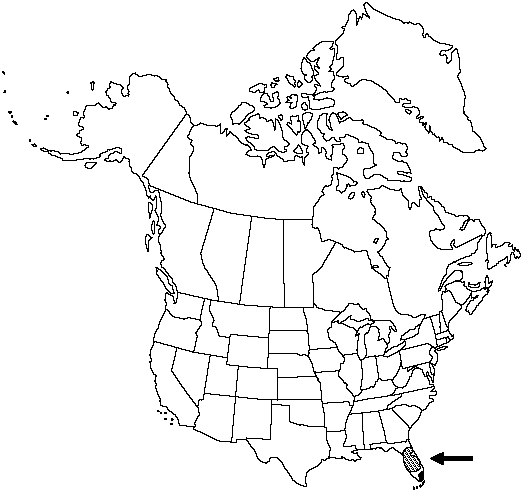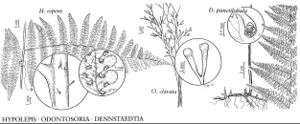Difference between revisions of "Hypolepis repens"
Tent. Pterid. 162. 1836.
FNA>Volume Importer |
imported>Volume Importer |
||
| (7 intermediate revisions by 2 users not shown) | |||
| Line 8: | Line 8: | ||
}} | }} | ||
|common_names=Creeping bramble fern;flakelet fern | |common_names=Creeping bramble fern;flakelet fern | ||
| − | |basionyms={{Treatment/ID/ | + | |special_status={{Treatment/ID/Special_status |
| + | |code=F | ||
| + | |label=Illustrated | ||
| + | }} | ||
| + | |basionyms={{Treatment/ID/Basionym | ||
|name=Lonchitis repens | |name=Lonchitis repens | ||
|authority=Linnaeus | |authority=Linnaeus | ||
| + | |rank=species | ||
| + | |publication_title=Sp. Pl. | ||
| + | |publication_place=2: 1078. 1753 | ||
}} | }} | ||
|synonyms= | |synonyms= | ||
| Line 20: | Line 27: | ||
}}<!-- | }}<!-- | ||
| − | --><span class="statement" id="st- | + | --><span class="statement" id="st-undefined" data-properties=""><b>Stems </b>long-creeping, branching, 2.5–4 mm diam., pubescence brown. <b>Leaves</b> 9–60 dm. <b>Petiole</b> straw-colored to reddish brown, 2–4(–6) dm, glabrous or pubescent, bearing prickles; primary pinnae similarly pubescent. <b>Blade</b> deltate, 3–4-pinnate-pinnatifid, lateral divisions opposite or nearly so, (2.5–)4–15 × 1.2–6 dm. <b>Rachis</b> nearly glabrous or glandular-pubescent, with prickles. <b>Ultimate</b> segments spreading, elliptic to lanceolate or oblong-elliptic, pinnatifid, 4–9 × 7 mm, abaxially paler, somewhat papery, nearly glabrous to glandular-pubescent, lobes rounded. <b>Veins</b> simple to 1-forked, ending just short of margins. <b>Sori</b> in sinuses of ultimate segment divisions, reniform to semicircular or appearing circular at maturity. <b>Indusia</b> formed from thin, recurved flap of blade tissue, sometimes obscured by sporangia when mature. <b>2n</b> = 208.</span><!-- |
-->{{Treatment/Body | -->{{Treatment/Body | ||
| + | |phenology=Sporulates essentially all year. | ||
|habitat=low hammocks and swamps, generally wet to moist wooded areas in circumneutral to subacid soils | |habitat=low hammocks and swamps, generally wet to moist wooded areas in circumneutral to subacid soils | ||
|elevation=0 m | |elevation=0 m | ||
|distribution=Fla.;West Indies;Mexico;Central America;South America. | |distribution=Fla.;West Indies;Mexico;Central America;South America. | ||
| − | |discussion=<p>Within the flora Hypolepis repens is found primarily in central peninsular Florida with disjunct populations in southernmost Florida and in northeastern Florida.</p> | + | |discussion=<p>Within the flora <i>Hypolepis repens</i> is found primarily in central peninsular Florida with disjunct populations in southernmost Florida and in northeastern Florida.</p> |
|tables= | |tables= | ||
|references= | |references= | ||
| Line 35: | Line 43: | ||
-->{{#Taxon: | -->{{#Taxon: | ||
name=Hypolepis repens | name=Hypolepis repens | ||
| − | |||
|authority=(Linnaeus) C. Presl | |authority=(Linnaeus) C. Presl | ||
|rank=species | |rank=species | ||
| Line 42: | Line 49: | ||
|basionyms=Lonchitis repens | |basionyms=Lonchitis repens | ||
|family=Dennstaedtiaceae | |family=Dennstaedtiaceae | ||
| + | |phenology=Sporulates essentially all year. | ||
|habitat=low hammocks and swamps, generally wet to moist wooded areas in circumneutral to subacid soils | |habitat=low hammocks and swamps, generally wet to moist wooded areas in circumneutral to subacid soils | ||
|elevation=0 m | |elevation=0 m | ||
| Line 48: | Line 56: | ||
|publication title=Tent. Pterid. | |publication title=Tent. Pterid. | ||
|publication year=1836 | |publication year=1836 | ||
| − | |special status= | + | |special status=Illustrated |
| − | |source xml=https:// | + | |source xml=https://bitbucket.org/aafc-mbb/fna-data-curation/src/2e0870ddd59836b60bcf96646a41e87ea5a5943a/coarse_grained_fna_xml/V2/V2_238.xml |
|genus=Hypolepis | |genus=Hypolepis | ||
|species=Hypolepis repens | |species=Hypolepis repens | ||
| − | |||
| − | |||
| − | |||
| − | |||
| − | |||
| − | |||
| − | |||
| − | |||
| − | |||
| − | |||
| − | |||
| − | |||
| − | |||
| − | |||
| − | |||
| − | |||
| − | |||
| − | |||
| − | |||
| − | |||
| − | |||
| − | |||
| − | |||
| − | |||
| − | |||
| − | |||
| − | |||
| − | |||
| − | |||
| − | |||
| − | |||
| − | |||
| − | |||
}}<!-- | }}<!-- | ||
-->[[Category:Treatment]][[Category:Hypolepis]] | -->[[Category:Treatment]][[Category:Hypolepis]] | ||
Latest revision as of 21:22, 5 November 2020
Stems long-creeping, branching, 2.5–4 mm diam., pubescence brown. Leaves 9–60 dm. Petiole straw-colored to reddish brown, 2–4(–6) dm, glabrous or pubescent, bearing prickles; primary pinnae similarly pubescent. Blade deltate, 3–4-pinnate-pinnatifid, lateral divisions opposite or nearly so, (2.5–)4–15 × 1.2–6 dm. Rachis nearly glabrous or glandular-pubescent, with prickles. Ultimate segments spreading, elliptic to lanceolate or oblong-elliptic, pinnatifid, 4–9 × 7 mm, abaxially paler, somewhat papery, nearly glabrous to glandular-pubescent, lobes rounded. Veins simple to 1-forked, ending just short of margins. Sori in sinuses of ultimate segment divisions, reniform to semicircular or appearing circular at maturity. Indusia formed from thin, recurved flap of blade tissue, sometimes obscured by sporangia when mature. 2n = 208.
Phenology: Sporulates essentially all year.
Habitat: low hammocks and swamps, generally wet to moist wooded areas in circumneutral to subacid soils
Elevation: 0 m
Distribution

Fla., West Indies, Mexico, Central America, South America.
Discussion
Within the flora Hypolepis repens is found primarily in central peninsular Florida with disjunct populations in southernmost Florida and in northeastern Florida.
Selected References
None.
